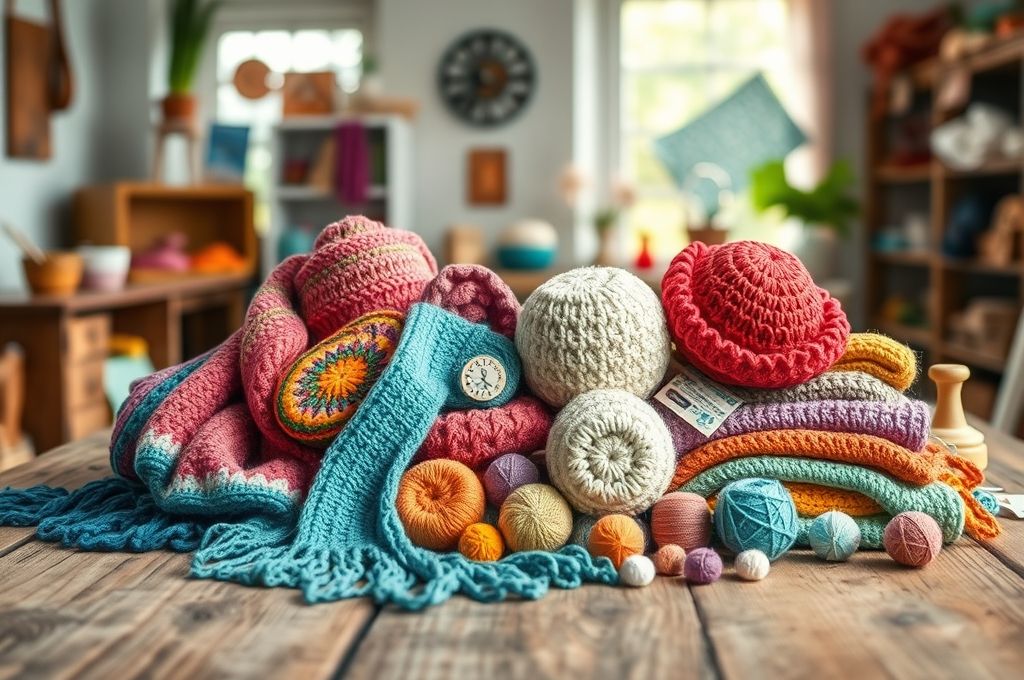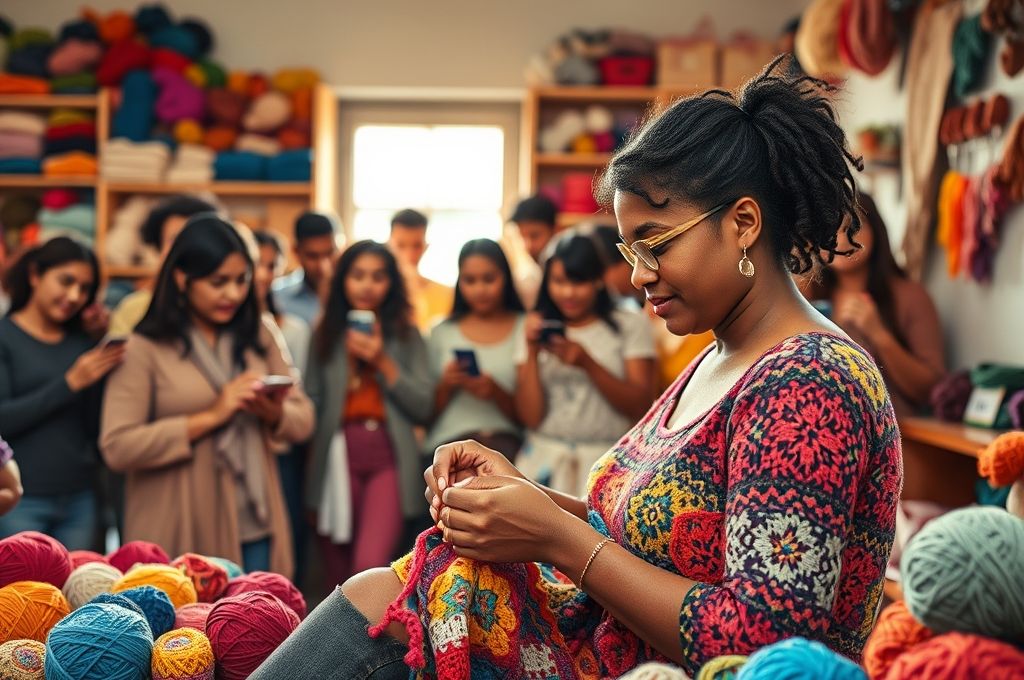The Power of Passion in a Digital World
Imagine turning your favorite hobby—crocheting—into a thriving online business. What once started as a quiet pastime, maybe while watching TV or listening to music, could now become a full-fledged brand with a loyal following across the globe. Sounds dreamy? It’s not. Thousands of crafters have done it, and you can too.
In today’s digital age, building a crochet brand isn’t just about making beautiful pieces—it’s about telling your story, connecting with people, and showing up consistently online. Whether you sell handmade items, offer patterns, teach classes, or simply share your journey, your online presence is your storefront, your studio, and your community all in one.
This article will guide you through the essential steps to build a strong, authentic crochet brand using social media and digital platforms. We’ll explore how to define your niche, choose the right platforms, create engaging content, grow your audience, collaborate with others, and stay inspired through the ups and downs of being a creative entrepreneur.
More than just tips, this is a roadmap for turning your passion into a purpose-driven brand. So grab your favorite hook, settle into your cozy corner, and let’s weave something meaningful—together.
1. Define Your Crochet Identity: Who Are You as a Brand?

Before you post your first photo or launch a website, ask yourself: What makes your crochet style unique? This is the foundation of your brand.
Your crochet identity goes beyond the colors and stitches you use. It includes your values, your voice, your mission, and even your personality. Are you all about bold, modern designs? Or do you specialize in nostalgic, vintage-inspired pieces? Maybe you focus on sustainable yarns or inclusive sizing in your patterns. These choices shape your brand’s character.
Think of your brand like a person. If it walked into a room, how would it dress? What would it say? Would it be playful, elegant, rebellious, or calming? Defining these traits helps you create a consistent image across all platforms.
For example, Sarah, a crocheter from Portland, built her brand around “slow crafting” and mindfulness. She uses earthy tones, shares behind-the-scenes videos of her process, and writes captions that feel like journal entries. Her audience doesn’t just buy her patterns—they feel seen and calmed by her presence.
To find your identity, try this simple exercise:
- List 5 adjectives that describe your work.
- Write down what you love most about crocheting.
- Identify 3 values that matter to you (e.g., sustainability, creativity, accessibility).
Once you have clarity, use these insights to guide your visuals, tone, and content strategy. A strong identity doesn’t limit you—it gives you direction and helps your ideal audience recognize you instantly.
2. Choose the Right Platforms: Where Does Your Audience Hang Out?
Not all social media platforms are created equal—especially for crafters. While it’s tempting to be everywhere at once, focusing on 1–2 key platforms will give you better results and less burnout.
Let’s break down the top platforms for crochet creators:
Instagram remains the go-to for visual storytelling. With features like Reels, Stories, and Guides, it’s perfect for showing off your textures, colors, and finished projects. Use hashtags like #crochetcommunity or #handmadelove to reach new followers.
Pinterest is a powerhouse for driving traffic. People use it to discover ideas and save projects for later. If you design patterns or sell digital downloads, Pinterest can send steady traffic to your website or Etsy shop. Create eye-catching pins with clear titles like “Easy Crochet Baby Blanket Pattern.”
TikTok is ideal for short, engaging videos. Show time-lapses of your work, stitch tutorials, or fun “day in the life” clips. The algorithm rewards authenticity, so don’t worry about perfection—just be real.
YouTube works well if you enjoy longer-form content. Tutorials, pattern walkthroughs, and vlogs help establish you as an expert. Plus, YouTube videos can rank in Google searches, giving you long-term visibility.
Etsy or Your Own Website should be your home base. Social media platforms can change their rules overnight, but your website is yours. Use it to sell products, collect emails, and showcase your portfolio.
Start with one platform that feels natural to you. Master it. Then expand when you’re ready. Consistency beats quantity every time.
3. Create Content That Connects—Not Just Captivates
You’ve picked your platform. Now, what do you post?
Many new crafters fall into the trap of only sharing finished projects. While beautiful photos are important, they don’t build connection. People follow people, not just products.
The key is to show the process, not just the result.
Share:
- A quick video of you starting a new project.
- A close-up of a tricky stitch you just mastered.
- A photo of your messy workspace with a funny caption.
- A story about why you chose a particular color or yarn.
These glimpses behind the curtain make you relatable. They invite your audience into your world.
For example, instead of just posting a picture of a rainbow amigurumi with “Just finished! 😍,” try:
“This little guy took way longer than I thought—especially those tiny eyes! But I refused to give up. Sometimes the messiest projects teach us the most. What’s the last thing you finished even when it got hard?”
See the difference? One is passive. The other invites conversation.
Also, mix up your content types:
- Educational: “How to fix a dropped stitch in single crochet”
- Inspirational: “Why I started crocheting again after 10 years”
- Interactive: “Which color should I use for the next row? Vote in stories!”
- Promotional: “My new sunflower hat pattern is live—get 20% off this week!”
Aim for a 70/30 rule: 70% value-driven content (tips, stories, inspiration), 30% promotional. This builds trust and keeps your audience engaged without feeling sold to.
4. Grow Your Audience with Authentic Engagement

Posting regularly is important, but engagement is what turns viewers into followers—and followers into customers.
Too many crafters post and ghost. They hit “share” and walk away. But social media is social. It’s a two-way street.
Here’s how to engage authentically:
- Reply to every comment, even if it’s just a heart or “so cute!”
- Ask questions in your captions to spark conversation.
- Respond to DMs with warmth and personality.
- Comment on other crocheters’ posts—especially small accounts.
Think of it like visiting a craft fair. You wouldn’t just set up your booth and stare at your phone, right? You’d chat with visitors, compliment others’ work, and make connections.
Engagement also helps the algorithm. Platforms reward accounts that generate conversations. The more replies and interactions your posts get, the more they’re shown to new people.
One powerful tactic? User-generated content (UGC). Encourage your customers or followers to share photos of your patterns or products. Repost them (with credit!) and celebrate their work. This builds community and gives you free, authentic content.
For example, Lisa, a pattern designer, started a monthly challenge: “Make my ‘Cozy Cactus’ and tag me.” She reposted every entry and gave a small prize. Her engagement tripled in two months.
Remember: people don’t follow brands—they follow people they like and trust. Be present. Be kind. Be real.
5. Tell Your Story: Why Your Journey Matters
People don’t just buy crochet items—they buy the story behind them.
Why did you start crocheting? Was it a gift from your grandma? A way to cope with anxiety? A creative outlet after years in a corporate job?
Your story is your superpower.
When you share your journey, you create emotional connections. And emotion drives action—whether it’s hitting “follow,” buying a pattern, or joining your email list.
Take Maya, a crocheter from Texas. She started making baby clothes after losing a pregnancy. Her brand, Little Stitches of Hope, now supports mental health charities. Her story isn’t just sad—it’s powerful, healing, and inspiring. Her audience doesn’t just admire her work—they support her mission.
You don’t need a dramatic story to be compelling. Even simple truths resonate:
- “I started crocheting during lockdown to stay sane.”
- “I wanted to make gifts that felt personal.”
- “I hated store-bought blankets—they never fit right.”
Share these moments in captions, blog posts, or short videos. Use phrases like:
- “Here’s the truth…”
- “This meant more to me than I expected…”
- “I almost gave up, but then…”
Storytelling doesn’t have to be long. A few honest sentences can do wonders.
And don’t forget to tie your story to your values. If you care about sustainability, talk about why you choose eco-friendly yarns. If you believe in slow fashion, explain how handmade pieces last longer and mean more.
Your story isn’t just marketing—it’s meaning.
6. Collaborate and Connect: Strength in the Crochet Community
One of the most beautiful things about the crochet world is its sense of community. Unlike some competitive industries, crafters often uplift each other.
Use that to your advantage.
Collaborations can boost your visibility, bring in new followers, and deepen your connections. And they don’t have to be complicated.
Here are simple ways to collaborate:
- Host a joint giveaway with another crocheter. You both promote it, and participants must follow both accounts.
- Do a stitch swap—you make a piece using their pattern; they use yours. Share the results online.
- Guest post on each other’s blogs or Instagram Lives.
- Join or create a crochet challenge (e.g., “30 Days of Granny Squares”).
These partnerships expose you to new audiences who already love crochet. And because trust is pre-established, they’re more likely to engage with you.
Also, participate in online events like:
- #CrochetAlong (CAL): A group works on the same pattern over several weeks.
- Yarn festivals or virtual craft fairs
- Hashtag communities like #MakeItHandmade or #FiberArtistsOfInstagram
When you show up for others—commenting, supporting, sharing—you build goodwill. And when you need support, that community will be there for you.
Remember: rising tides lift all boats. Celebrate others’ wins. Share their work. Be generous with your time and praise.
The crochet community isn’t just a network—it’s a family.
7. Build a Website That Works for You (Even If You’re Not Tech-Savvy)
Social media is great, but it’s not yours. Platforms can change algorithms, suspend accounts, or disappear entirely.
Your website is your safe space.
You don’t need to be a web developer to create a professional-looking site. Tools like Shopify, Wix, or Squarespace offer easy drag-and-drop builders. Many even have templates made for artists and crafters.
Your website should include:
- A portfolio of your work (photos with descriptions)
- A shop (if you sell physical or digital products)
- An About page with your story and photo
- A contact form or email link
- A newsletter signup (more on this soon)
Even if you don’t sell anything yet, a simple site with your best projects and a way to reach you looks professional and builds credibility.
And here’s a pro tip: Use your website to collect emails.
Why? Because your email list is the most reliable way to reach your audience. Unlike social media, you own it. You can share new patterns, announce sales, or send heartfelt updates directly to inboxes.
Offer a freebie—like a beginner’s crochet guide or an exclusive pattern—to encourage signups. It’s called a “lead magnet,” and it works.
One crocheter, Jen, grew her email list to 5,000 in a year by offering a free “10 Quick Crochet Gifts” PDF. She now sells her patterns primarily through email promotions.
Your website doesn’t have to be fancy. It just has to be yours.
8. Stay Inspired and Avoid Burnout: The Creative’s Balancing Act
Here’s the truth no one talks about: building a brand can be exhausting.
You’re creating, photographing, editing, posting, replying, shipping, and dreaming up new ideas—all while trying to live your life.
Burnout is real. And it sneaks up quietly.
One day you’re excited to post. The next, you can’t even pick up your hook.
So how do you stay inspired?
First, set boundaries. Decide how much time you’ll spend on your brand each week. Maybe it’s 5 hours. Stick to it. Protect your creative energy.
Second, take breaks. Step away from screens. Go for a walk. Visit a yarn store just for fun—not for content.
Third, consume inspiration. Follow other artists, read books, watch documentaries, or try a new craft. Fill your cup so you can keep creating.
Fourth, celebrate small wins. Sold one pattern? Got a kind comment? Finished a project you love? Acknowledge it. Joy fuels creativity.
And finally, remember your “why.” Why did you start? Was it joy? Connection? Self-expression? Reconnect with that feeling when things get tough.
You don’t have to grow fast. You don’t have to be perfect. You just have to keep showing up—on your terms.
9. Turn Passion into Profit: Monetizing Your Craft (Without Losing Authenticity)
Let’s talk money—because yes, you can earn from your crochet.
But the key is to do it in a way that feels true to you.
Here are honest ways to monetize:
- Sell handmade items on Etsy, at craft fairs, or through your website.
- Create and sell digital patterns—they’re scalable and low-cost to produce.
- Offer online courses or workshops (via Teachable or Patreon).
- Sell yarn kits with your pattern and curated materials.
- Accept commissions for custom pieces.
- Partner with brands as an affiliate or ambassador (e.g., promote a yarn company you love).
The secret? Start small and test. Don’t launch 10 products at once. Try one pattern. See how it sells. Get feedback. Improve.
Also, be transparent. If you’re promoting a product, say so. Use #ad or #affiliate. Honesty builds trust.
And don’t undervalue your work. It’s easy to underprice because you love what you do. But your time, skill, and creativity have worth.
One crocheter, Emma, started charging $5 for a simple beanie pattern. After getting messages like “This changed my crocheting!” she realized her value. She now charges $12 and sells thousands of copies a year.
You don’t have to choose between passion and profit. You can have both—when you respect your craft.
10. Keep Weaving Forward: Your Brand Is a Living Thing
Building a crochet brand isn’t a one-time project. It’s a journey—one that evolves as you do.
You’ll have months where growth feels slow. And others where everything clicks. Both are part of the process.
Your brand will change. Maybe you shift from selling items to teaching. Maybe you discover a new style. Maybe you take a break and come back with fresh energy.
And that’s okay.
What matters is that you stay true to yourself. Show up with kindness, creativity, and consistency. Share your work, your story, and your heart.
Every post, every stitch, every reply is a thread in the bigger tapestry of your brand.
And over time, those threads form something beautiful—not just a business, but a legacy of creativity and connection.
So keep going. Keep crocheting. Keep sharing.
The world needs your handmade magic.
Conclusion: Your Hook, Your Voice, Your Impact
We’ve covered a lot—from defining your brand identity to growing your audience, from storytelling to staying inspired. But the heart of it all is simple: you matter.
Your unique voice, your creative hands, and your personal journey are what make your crochet brand special. No algorithm, trend, or competitor can replicate that.
Building an online presence isn’t about chasing likes or going viral. It’s about showing up as yourself, sharing your passion, and connecting with people who appreciate what you make.
Start small. Be consistent. Be kind—to your audience and to yourself.
And remember: every expert was once a beginner holding a hook and wondering, Can I really do this?
Yes, you can.
Now, I’d love to hear from you:
What’s one step you’ll take this week to grow your crochet brand?
Share it in the comments or tag me on social media—I’m cheering for you.
Keep creating. Keep connecting. And keep weaving your story, one stitch at a time.

Daniele Ferreira is passionate about the world of crochet, dedicating her time to exploring techniques, creating unique pieces, and sharing her knowledge with beginners and aficionados alike. With attention to detail and creativity, she transforms yarn into true works of art, inspiring others to discover the beauty and joy of this manual art.







